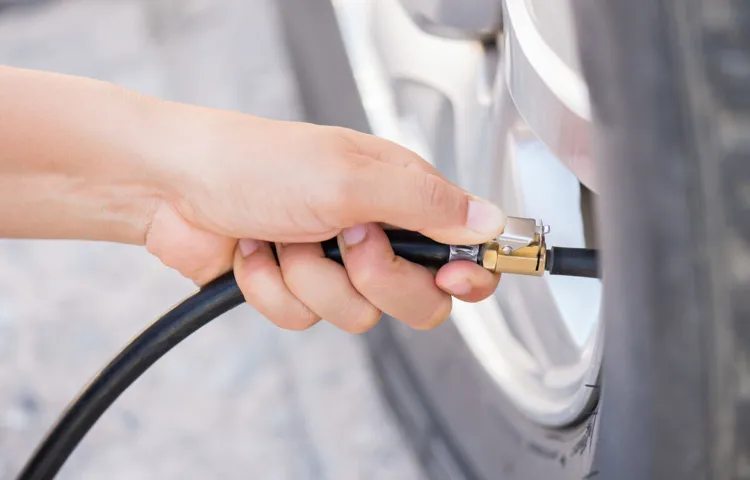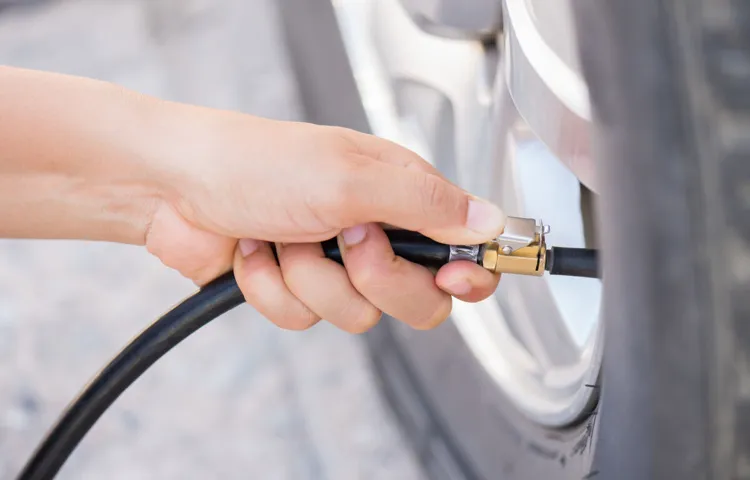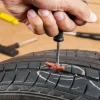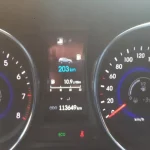When you’re out on the road, the last thing you want is to have a flat tire. And if you’re really unlucky, you may find out that your spare tire is flat too. But don’t worry, putting air in a spare tire is a lot easier than you might think! In this blog post, we’ll go through the steps you need to take to put air in your spare tire so you can get back on the road in no time.
So let’s get started!
Table of Contents
Check Tire Pressure
If you ever find yourself with a flat tire and need to put air in your spare tire, the first step is to locate the spare tire and the tire valve on it. Once you have found the valve, you can proceed to check the tire pressure with a tire pressure gauge. If the pressure is low, you can inflate the tire with a portable air compressor or at a gas station with an air pump.
Just make sure you inflate the tire to the recommended pressure level, which you can find in the owner’s manual or on the tire itself. It’s important to note that a spare tire is not meant to be driven on for extended periods, so make sure you get your flat tire repaired or replaced as soon as possible. By keeping your spare tire properly inflated, you can ensure that it’s ready to use in case of an emergency on the road.
Gather Materials: Tire Gauge & Air Compressor
Checking your tire pressure should be a routine task for every car owner to ensure the safety and longevity of their vehicle. Gather the necessary materials, a tire gauge, and an air compressor if needed, to begin the process. First, remove the valve cap from the tire and press the tire gauge onto the valve stem.
The gauge will give you a reading of the pressure inside the tire. Check the recommended pressure for your specific vehicle in the owner’s manual or on the label inside the driver’s door. If the pressure is too low, use the air compressor to inflate the tire to the recommended level.
Overinflating the tire is just as dangerous as underinflating, so be sure to check the pressure regularly and keep it within the recommended range. Checking tire pressure not only promotes safety but also improves fuel efficiency and saves you money in the long run. Make it a habit to check your tire pressure regularly to prolong the life of your tires and maintain a safe driving experience.

Locate the Spare Tire
When it comes to checking tire pressure, it is crucial to know where your spare tire is located. Many people assume that spare tires are stored in the trunk, but this is not always the case. Some cars have it under the vehicle, while others have it mounted on the back.
Take the time to locate your spare tire before an emergency arises, and ensure that it is in good condition and properly inflated. Checking tire pressure is an essential part of maintaining your vehicle’s health and safety. Low tire pressure can cause decrease your fuel efficiency and pose a danger on the road.
It is recommended to check your tire pressure at least once a month and before long trips. You can find the recommended tire pressure for your specific vehicle in the owner’s manual or on the inside of the driver’s side door. An underinflated tire can cause the vehicle to be less stable and require a longer stopping distance.
Make sure to use a tire pressure gauge to ensure that your pressure is at the recommended level, as relying on visual inspection can be inaccurate. By regularly checking your tire pressure and locating your spare tire, you can prevent inconvenience and increase your vehicle’s safety.
Remove the Spare Tire from Vehicle
If you ever find yourself with a flat tire on the road, having a functioning spare tire can be a lifesaver. However, many people don’t realize that the spare tire often needs to be checked and inflated just like the rest of the tires. To put air in a spare tire, first remove it from the vehicle and place it on a flat surface.
Then, locate the valve stem and remove the cap. Use a tire gauge to check the current pressure and determine how much additional air is needed. Attach a portable air compressor or visit a nearby gas station with an air pump to inflate the tire to the correct pressure level.
Once the tire is properly inflated, replace the valve stem cap and re-install the spare tire in your vehicle. Remember to also periodically check the spare tire pressure to ensure it is ready for emergencies.
Place the Spare Tire on Flat Surface
When you get a flat tire, the first thing you need to do is remove the spare tire from your vehicle. It’s essential to know where it’s located and how to get it out safely. Once you’ve retrieved the spare tire, you need to place it on a flat surface before doing anything else.
This is important because you don’t want the tire to roll away while you’re working on it, so you need to find a stable and level area to set it down. It could be the pavement or the sidewalk depending on where you are. Just make sure it’s not on an incline or a slope that might cause it to move.
Remember to use the lug wrench to loosen the lug nuts before jacking up the vehicle. This will make removing the flat tire and replacing it with the spare a lot easier. By following these simple steps, you can safely and quickly change your tire and get back on the road.
Detach the Valve Cap
When it comes to putting air in your spare tire, the first step is to detach the valve cap. This small cap protects the valve stem from dirt and debris, but it needs to be removed before you can add air. To remove the cap, simply twist it counterclockwise until it comes off.
Be sure to keep it in a safe place, so you don’t lose it during the process. Once the cap is off, you will be able to access the valve stem, which is where you will insert the air hose. Make sure your tire gauge is handy, so you can accurately measure the tire pressure as you fill your spare.
With the valve cap off and the air hose in place, you’ll be able to inflate your tire until it reaches the recommended pressure level. It’s important to note that over-inflating your tire can be just as dangerous as under-inflating it, so be sure to follow the manufacturer’s guidelines for proper inflation. With these simple steps, you’ll be able to get your spare tire back in action in no time!
Insert the Tire Gauge into the Valve Stem
When it comes to checking your tire pressure, there are a few important steps to follow. One of the first things you’ll need to do is detach the valve cap from the valve stem. This small cap helps to keep debris and dirt out of the stem, so it’s important not to lose it.
Once you’ve removed the cap, you’ll be able to insert the tire gauge into the valve stem. This can be a little tricky at first, but with practice, you’ll get the hang of it. The tire gauge will give you a reading of your tire pressure, which you can use to adjust the pressure as needed.
It’s important to check your tire pressure regularly to ensure that your tires are properly inflated. This not only helps to improve your car’s performance and gas mileage, but it’s also essential for your safety. So, be sure to detach the valve cap and insert the tire gauge into the valve stem to get an accurate reading of your tire pressure.
Check Tire Pressure
One important step in maintaining your car’s optimal performance and safety is regularly checking your tire pressure. By doing so, you not only extend the lifespan of your tires, but you also improve fuel efficiency and prevent potential blowouts or accidents. However, before you begin checking tire pressure, it’s important to detach the valve cap.
This small, often overlooked component allows you to access the valve stem, where you can attach your pressure gauge and accurately assess your tire pressure. So, the next time you’re performing routine maintenance on your vehicle, don’t forget to remove the valve cap before checking your tire pressure. Your car (and wallet) will thank you for it in the long run!
Add Air to Tire
Knowing how to put air in a spare tire is an essential skill for every driver. Having a flat tire can be frustrating, but if you have a spare tire and know how to add air to it, you can quickly get back on the road. First, locate your spare tire.
It’s often stored underneath your car or in the trunk. Once you’ve found it, remove the valve stem cap and use a tire pressure gauge to check the tire’s PSI. If it’s below the recommended level, use an air compressor or stop at a gas station to add air.
Be sure to check the tire’s PSI after adding air to ensure it’s at the correct level. Remember, your spare tire is only meant to be a temporary fix, so be sure to get it replaced as soon as possible. By having a properly inflated spare tire, you can avoid being stranded and make it to your next destination with ease.
Connect the Air Compressor to the Tire Valve
After checking the tire pressure, you may find that it’s too low and needs air. Adding air to your tire is simple, and the first step is connecting the air compressor to the tire valve. Before getting started, make sure you have the right tire pressure gauge and air compressor, and that they are compatible with each other.
The tire valve is usually located on the side of the tire and has a cap on it. Remove the cap and attach the air compressor nozzle to the valve stem. Make sure it’s attached securely and turn on the compressor.
You’ll hear a hissing sound as the air flows into the tire. Keep an eye on the pressure gauge and stop adding air once it reaches the recommended pressure level. It’s important not to overinflate the tire, as this can cause damage.
After you’re done, disconnect the air compressor and replace the valve cap. By following these simple steps, you can add air to your tire and ensure that your vehicle is safe for the road.
Inflate the Tire to the Recommended Pressure Level
Adding air to your car’s tire may seem like a daunting task, but it’s an essential part of maintaining your vehicle’s health and prolonging its lifespan. The first step is to consult your owner’s manual or the tire information label on the driver’s side door jamb to determine the recommended tire pressure level. Using a tire gauge, check your tire’s current pressure level and compare it to the recommended level.
If the pressure is low, it’s time to add air. To add air, locate a gas station with an air pump and pull up next to it. Remove the valve cap on the tire and attach the air hose to the valve, ensuring a tight fit.
Turn on the pump and add air in short bursts, checking the pressure frequently with the tire gauge. Avoid over-inflation, as this can cause handling issues and increase the risk of a blowout. Remember, properly inflated tires not only improve handling and fuel efficiency but also help prevent premature wear and tear.
It’s a quick and easy task that can save you money and keep you safe on the road. So, take a few minutes to inflate your tires to the recommended pressure level and keep on cruising.
Check Tire Pressure Again
If you’re dealing with a flat tire and have managed to replace it with your spare, congratulations! However, your job is not quite done yet. It’s important to double-check the tire pressure of your spare tire before hitting the road again. The process of putting air in your spare tire is the same as with any other tire.
First, locate the valve stem on the side of the tire. Then, remove the cap from the stem. Take your tire gauge and press it onto the valve stem firmly until you hear a hissing sound.
The gauge will give you an accurate reading of the tire pressure. If it’s too low, use an air compressor to fill it up. Once you’ve achieved the correct pressure level, replace the valve cap and pack up your tools.
Remember to regularly check your spare tire pressure to avoid any future mishaps while on the road!
Remove Tire Gauge and Reattach Valve Cap
After you’ve used your tire gauge to check your tire pressure, you’ll want to remove the gauge and reattach the valve cap to your tire. It’s important to make sure that the valve cap is snugly in place because it helps to prevent dirt and debris from getting inside the valve and causing problems later on. Once you’ve reattached the valve cap, double-check your tire pressure one more time to make sure it falls within the recommended range.
This is especially important before a long trip or if you haven’t checked your tire pressure in a while. Maintaining the correct tire pressure not only helps to improve your vehicle’s fuel efficiency, but also enhances safety on the road. So, take a few extra minutes to check your tire pressure regularly – it’s a small task that can have a big impact on your driving experience and your wallet.
Return Spare Tire to Vehicle
Have you ever wondered how to put air in a spare tire? It may seem like a daunting task, but it’s actually quite simple. The first step is to locate the spare tire and remove it from the car. Once you have the spare tire, check to see if it needs air by using a tire pressure gauge.
If it does, you will need to inflate it to the recommended pressure level – usually listed in your car’s manual. You can use a portable air compressor or stop by a gas station with an air pump to inflate the tire. After inflating the spare tire, it’s important to return it to your vehicle in the proper location, ensuring it is securely fastened in place.
It’s also a good idea to regularly check the air pressure in your spare tire to ensure it’s always ready to use in case of an emergency. Remember, your spare tire is your lifesaver on the road, so take the time to care for it properly.
Conclusion
In the game of life, having a spare tire is essential, but knowing how to inflate it is the real MVP move. Don’t be left stranded on the side of the road with a flat spare! Follow these simple steps to pump up that rubber donut like a pro and get back on the road to adventure. Remember, when it comes to your spare tire, air is key, but a little bit of know-how is the real lifesaver.
“
FAQs
Why is it important to regularly check the air pressure in your spare tire?
It is important to regularly check the air pressure in your spare tire because over time, the tire can lose air and become deflated, rendering it useless in an emergency situation.
How do I find the recommended air pressure for my spare tire?
The recommended air pressure for your spare tire can typically be found in your vehicle’s owner manual or on a sticker located in the trunk or near the spare tire itself.
Can I use a regular tire inflator to put air in my spare tire?
Yes, a regular tire inflator can be used to put air in your spare tire. However, it is important to make sure that the inflator is compatible with your spare tire’s valve stem.
What should I do if I don’t have an inflator or air compressor to put air in my spare tire?
If you don’t have an inflator or air compressor, you can take your spare tire to a nearby gas station or auto repair shop to have it inflated.
How often should I check the air pressure in my spare tire?
It is recommended to check the air pressure in your spare tire at least once a month, or before going on a long road trip.
Can I drive with a spare tire that is not fully inflated?
It is not recommended to drive with a spare tire that is not fully inflated, as it can affect your vehicle’s handling and potentially cause further damage.
Do I need to replace my spare tire if it is damaged or has low tread depth?
Yes, if your spare tire is damaged or has low tread depth, it should be replaced. Your spare tire is designed to be a temporary solution and may not be safe to use in certain conditions.




